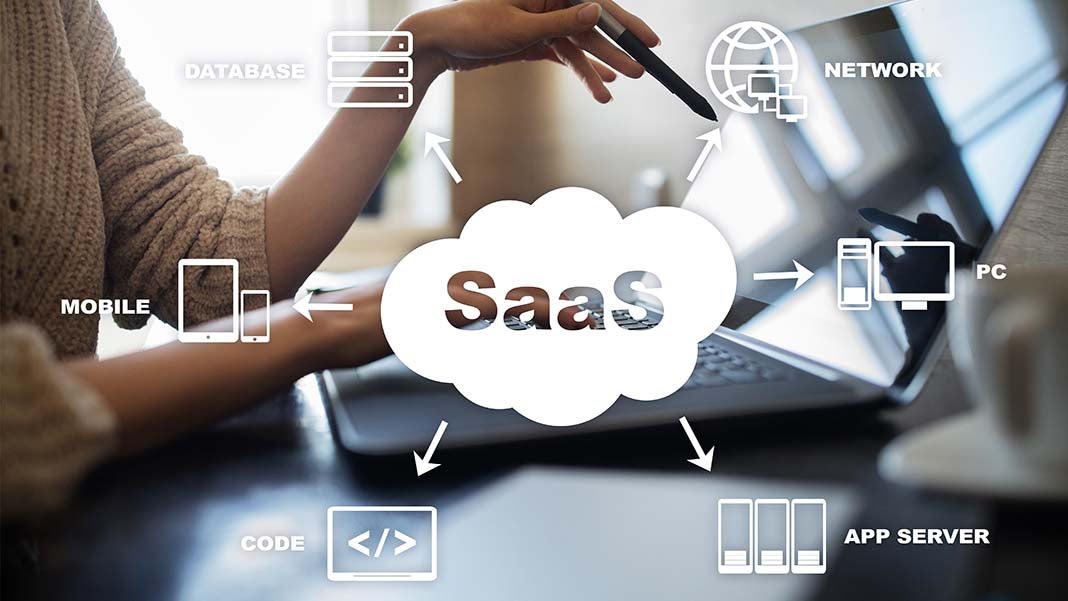
Software as a Service (or SaaS) applications are widely used nowadays for various advantages they provide to your customers. Slowly but surely they become a new main way of distributing services, replacing the physical model.
 In this article, we take a look at SaaS, consider their overall relevance in 2022, pinpoint the main risks and benefits of using a SaaS app for your customers, and give you a step-by-step guide on how to develop a SaaS application.
In this article, we take a look at SaaS, consider their overall relevance in 2022, pinpoint the main risks and benefits of using a SaaS app for your customers, and give you a step-by-step guide on how to develop a SaaS application.
What’s SaaS?
SaaS is a model for the digital distribution of services; the defining feature here is that the app is hosted remotely in the cloud.
Usually, SaaS apps can be accessed from any modern mobile device with Internet access and a browser. In case a customer needs to expand their business, all they need to do is select an appropriate pricing plan.
Unlike traditional apps, SaaS uses temporary subscriptions and is constantly supported and upgraded by SaaS software developers. Your clients won’t ever need to download patches for a SaaS application, each time they access it they get the latest version.
Why consider the development of a SaaS application in 2022?
The effectiveness of SaaS product development services is substantiated by the rapid growth of their market, which is expected to seize about half of the global digital business by 2028. Cloud technologies are gaining ground rapidly: it is expected that by the end of this year about 80 percent of apps are going to be SaaS.
It’s all about simplicity: software projects development, creation of online stores, CRMs, ERPs, PM apps, and much faster with SaaS. When your customers subscribe to a SaaS service, they get all the tools they need for their business, software code distribution, a license key, and support center access.
Benefits and risks of using a custom SaaS app
Despite being a step away from the traditional method of software distribution, SaaS still provides all the major benefits of its predecessors and adds some. Here’s a short list:
Cost Reduction
Your clients cut all costs for purchasing, installing, and maintaining the software infrastructure when they subscribe to SaaS. The service provider gets the subscription payment and customers get everything they need to run their business. There are even SaaS cards you can use to manage your recurring software expenses.
Easy access
SaaS apps are much more accessible than traditional software. The client would need a device and a reliable internet connection and they’re ready to go. Use the app anytime and anywhere.
Better scalability
If your client’s enterprise grows and they need to scale the software accordingly, they just select a new subscription plan with wider options, more users allowed, etc. There’s no need to purchase new software or worry about server space.
Upgradeability
SaaS application upgrades are managed by the service provider. The customer won’t ever need to worry about allocating business resources to updating.
Increased business resilience
With SaaS, all the information is stored remotely in the cloud; whatever disaster hits the enterprise location, your clients can relocate to any other spot with Internet access and continue working.
Disadvantages of SaaS
SaaS is great and gets better constantly. However, there are downsides too. Here’s a list of cons for using SaaS solutions:
Lacking information security
A possible lack of data security needs to be thoroughly addressed before deciding to work with SaaS software developers. The main thing here is management software access: clients are going to trust some sensitive information of their companies to a third-party provider.
Difficulty with regulations compliance
Every government has its regulations for information security. A customer would need to learn all the regulations that apply to their activity and discuss them with the SaaS service provider.
Data mobility issues
There are a ton of SaaS providers on the market, and some of them might not have what it takes to survive in a competitive environment. In case the provider goes down, transferring the data to another one might be clumsy.
Complications with software integration
Often a client would need to integrate their in-house software with their SaaS solution. Complications might arise in case APIs and data architecture is not compatible with the SaaS architecture design, so compatibility checks are paramount.
Steps for a successful SaaS product development
- Market research
Make sure that your business idea is sustainable in the current market. Get to know what your potential customers demand and what your competitors are doing. Is your target audience ready to pay for the product? Can you satisfy their needs? Get these out of the way before getting deep.
- Defining the app requirements.
Clarify all the details for your future SaaS solution: customization plan, integrating your in-house software, establishing the secure environment. A scaling plan would also be a good idea.
- Defining the MVP
Basic SaaS app features are essential for your business. What value are your customers going to get? MVP is subject to initial testing which will define the way to build a SaaS product.
The basic aspects to define the MVP are your user persona and the solutions you provide to help solve your customers’ problems.
- Choosing the right pricing model
The popularity of your product will largely depend on the SaaS monetization model, so it should be adjusted to your target audience. There are several models to choose from, such as usage-based pricing or pricing based on the number of features you provide.
- Technology stack
At this stage, you need to clarify the software development tech stack: what programming languages and tools to use. Usually, these aspects are decided on after consulting with professionals and require a strong understanding of the desired product and MVP.
- Creating the team
At this point, you need to decide whether you want to outsource the development or create your team. Outsourcing can be a great way to get the development process off your shoulders and focus on other business aspects.
- Budget estimation
By this time, you should already have a clear picture of your SaaS development costs. Plan your company’s budget accordingly, taking into account the time you need to start making a profit and recompensate your expenses.
We’re going to focus on the evaluation of costs a bit more now.
How much does it cost to create a SaaS application?
The final price can amount to tens or hundreds of thousands, or even reach and surpass the million limit.
Here are the main factors that determine the final cost:
- The application scope
Are you going to build a SaaS application as a platform, or a tool? A SaaS tool is specific, focused, and limited, while a SaaS platform acts as a combination of tools for solving multiple customer requirements. Think of it this way: Facebook is a platform, Facebook Messenger is a tool.
Platforms are going to be much more expensive in development.
- The app features
What range of functionalities would you require from your SaaS app? Each additional feature will expand the costs by its complexity.
- API Integration
API integration is required to ensure interaction between your SaaS and other apps, such as third-party payment systems, for example. You can choose to develop the back-end functionality for your app instead, but it would usually cost more.
- Selection of the development platform
SaaS apps can be developed for web or mobile platforms, the choice will determine the UX requirements, which are very different. Developing a SaaS for both platforms will cost significantly more.
- Project deadlines
The SaaS app development process can take from 3-4 months to a year or more. The exact time will depend on all the choices you made, such as the number of features and complexity of the application.
There are also some additional expenses, such as licensing, subscription, and others that will depend on your application.
Some concluding thoughts on the matter
The SaaS concept is constantly gaining more ground in the digital technology market, slowly but surely making the traditional distribution business model a thing of the past. The traditional model is still viable in most environments but sticking to it for your application might be a risky choice, considering the possibility of it getting outdated soon.
Still, the final choice is yours, and we hope that we’ve provided you with enough information and SaaS software development best practices to make it efficient.
1638 Views












